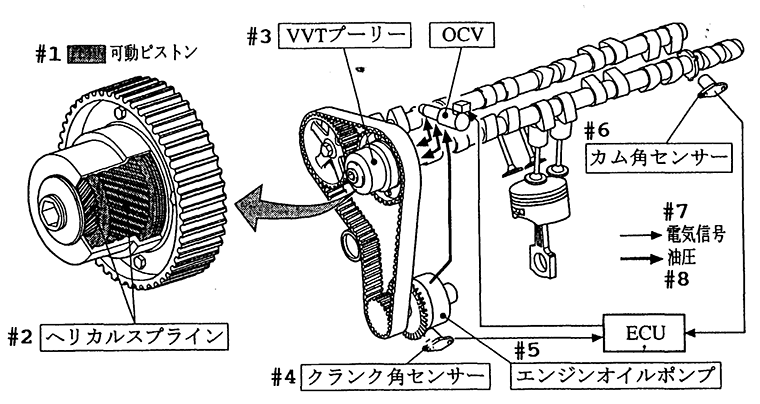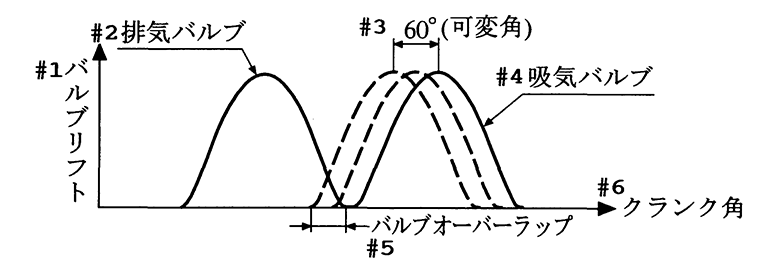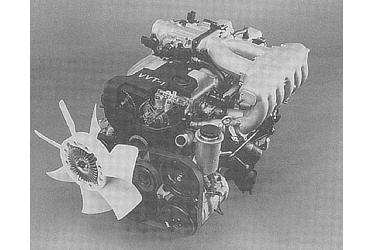Jun. 19, 1995
Toyota Develops New VVT-i Engine Technology
Provides Outstanding Performance and Fuel Economy
Tokyo―TOYOTA MOTOR CORPORATION announced today the development of its new "Variable Valve Timing-intelligent" (VVT-i) technology, which increases performance and fuel economy.
Engine development today necessitates both better fuel economy and advanced vehicle performance. Modern engines must also meet the social requirements of natural resource conservation and environment preservation.
In 1991, Toyota introduced the WT mechanism on its 4A-GE sports engines in order to increase engine torque and output. WT enables the intake valve to open and close in two steps, based on engine operating conditions.

Engine with VVT-i Technology

Fig. 1. VVT-i System
VVT-i is an improved version of the WT mechanism. By continuously changing the open/close timing of the intake valve, VVT-i provides optimum valve timing based on driving conditions. VVT-i advantages include increased torque and output, better fuel economy, and reduction of nitrogen oxide (NOx) and hydrocarbon emissions.
The simple structure of the VVT-i makes it extremely reliable and easy to adapt for existing engine designs. Wide applications of the new technology are expected in the future.
VVT-i will first be employed for engines used on a new model scheduled to be introduced within the year. Tests have confirmed that VVT-i increases fuel economy by about 6% and raises low and medium-range torque by about 10%.
Design
VVT-i is comprised of three major components: (1) the electronic control unit (ECU), which calculates optimum intake valve timing based on engine operating conditions; (2) the oil control valve (OCV), which controls hydraulic pressure under the ECU's instruction; and (3) the WT pulley, which continuously changes the intake valve timing using hydraulic pressure. The WT pulley does not need an additional pump to function because it uses the conventional engine oil pump.
In VVT pulley operation, a piston with a helical spline is moved hydraulically in the direction of the camshaft axis to move the camshaft by the exact amount required.

Fig. 2. Valve Timing with VVT-i (Schematic)
Toyota's new manufacturing technology has made it possible to make the helical spline with a large spiral angle of (30°) . This produces a very swift response and a large variable angle (up to 60° crankshaft angle) with a small stroke in the direction of the camshaft axis.
The OCV provides another advantage by continuously controlling the hydraulic pressure for both advancing and retarding the valve timing.
Performance Features
- Improved Fuel Economy and Reduced NOx and Hydrocarbons
Valve overlap (the timing when both intake and exhaust valves are open), created by continuous, broad control of intake valve timing based on the engine load and speed, increases fuel economy and reduces NOx and hydrocarbon emissions.In a conventional gasoline engine, the throttle valve controls the air intake when the accelerator pedal is not completely pressed down (partial-load driving). This generates vacuum pressure within the cylinder, causing extra load on the piston (pumping loss).In contrast, an engine with VVT-i advances the timing for opening the intake valve during partial-load driving, increases valve overlap, and draws partial exhaust gas back into the cylinder. This produces three results: (1) negative pressure inside the cylinder is mitigated to reduce intake loss and increase fuel economy; (2) combustion temperature is lowered to reduce NOx; and (3) unburned gas is returned to the combustion chamber to be reburned, reducing hydrocarbons.The valves do not overlap to stabilize combustion when the engine is idling, and the idling speed is lowered to improve fuel economy.
- Increased Torque and Output
During high-load driving conditions that require high torque and output, the intake valve timing is given optimum (continuous and broad) control based on engine speed. The intake inertia effect is fully utilized to increase intake air, thus raising torque and output.To increase the amount of intake air, the timing for intake valve closing must be determined in relation to the intake inertia effect and the intake air return caused by a rising piston. Optimum timing changes in accordance to the engine speed.The VVT-i engine increases low- and medium-speed torque by controlling, in advance, intake valve closing in the low- and medium-speed ranges. With an increase in engine speed, the timing for closing the intake valve is retarded to raise output.





